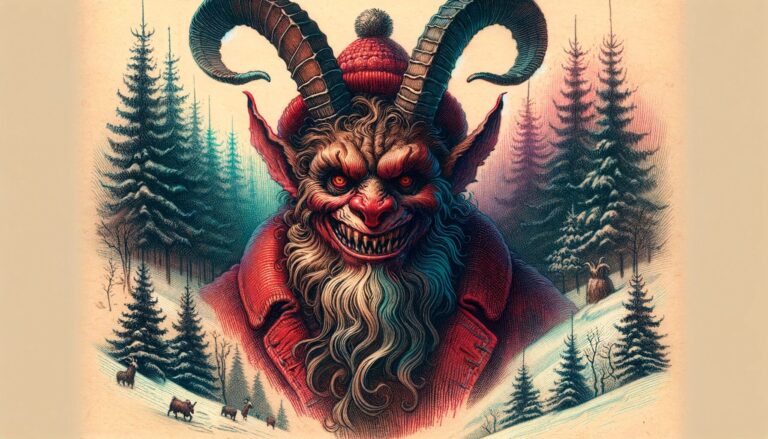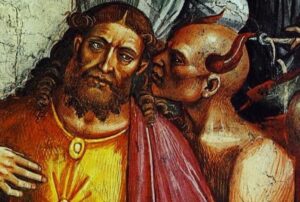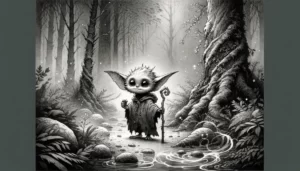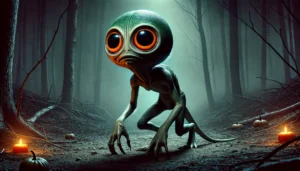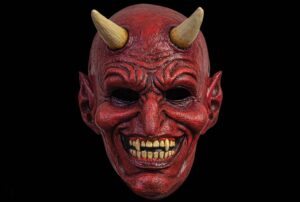Table of Contents
In the heart of Alpine cultures, where Christmas spirit reigns, exists a dark companion to Saint Nicholas: Krampus. This Christmas demon punishes children on the naughty list, far from coal in stockings. Explore Krampus, his chilling characteristics, and gruesome punishments for misbehaving children.
Physical Description
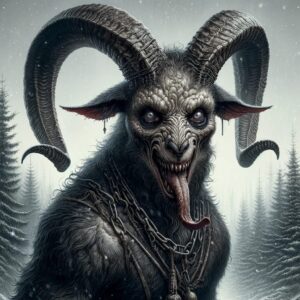
Krampus borrows a goat’s nightmarish features, including long curling horns atop his head, cloven hooves, shaggy fur (white, black, or reddish-brown), and an elongated, pointed goat-like tongue. In addition to his ghastly appearance, his mouth hosts gnarly fangs, and he walks upright, unsettling all who see him.
Draped in a macabre ensemble, Krampus wears chains that clank ominously and jingling bells. Moreover, in his clawed hands, he wields birch rods, a horsehair whip, and a large sack for hauling evildoers to the underworld.
Personality
Krampus is merciless, but not indiscriminate. He strictly targets misbehaving children, finding joy in punishing the wicked while never harming the innocent. Importantly, Krampus obeys Saint Nicholas, appearing as summoned.
Punishments
Krampus employs various cruel methods:
- Birch Rods: He whips and thrashes misbehaving children with birch rods, leaving painful welts as a lasting reminder.
- Horsehair Whip: Krampus wields a horsehair whip, its sting inducing dread and leaving searing marks.
- The Sack of Doom: His large sack captures the truly vile children, spiriting them away to the underworld, never to return.
Cultural Representation:
History
Krampus originates from pagan rituals, initially linked to the Horned God. Furthermore, birch rods may date back to ancient pagan ceremonies, and some associate him with the Norse God, Hel. However, as Christianity replaced pagan festivities with Christmas, Krampus shifted to an association with the devil, becoming subservient to Saint Nicholas. Moreover, in the 1920s, bans in Germany and Austria led to Krampus resurfacing as a kitschy folklore figure.
Modern Appearances
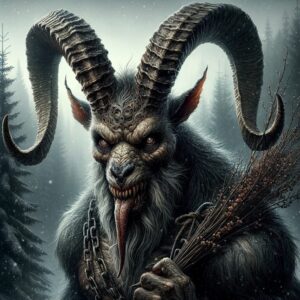
Krampus remains relevant in modern times, with global Krampusnacht celebrations on December 6. Young men parade as Krampus, snarling and rattling chains, blending ancient customs with modern revelry. Krampus also inspires horror literature and films, solidifying his holiday-season legacy as a figure of fear.
In conclusion, Krampus reminds us that the holiday season isn’t just about joyous carols. His gruesome punishments contrast with Saint Nicholas, ensuring that misdeeds are never forgotten. Rooted in pagan traditions and reimagined in the modern age, Krampus endures as an unsettling figure in Alpine folklore, teaching the consequences of naughty behavior.
Movies
“Krampus” (2015): This horror-comedy film directed by Michael Dougherty puts a dark and comedic spin on the Krampus legend. It follows a dysfunctional family who must come together to survive when they inadvertently summon the wrath of Krampus.
“A Christmas Horror Story” (2015): This anthology horror film features a segment about Krampus. It intertwines multiple holiday-themed horror stories, and Krampus plays a menacing role in one of them.
“Krampus: The Reckoning” (2015): This low-budget horror film explores the more sinister side of Krampus as it unleashes terror on a small town.
“Krampus Unleashed” (2016): Another low-budget horror movie, it continues to explore the theme of Krampus seeking revenge.
Literature
“Krampus: The Yule Lord” by Brom (2012): This novel is a dark fantasy tale that weaves the Krampus legend into a modern-day setting. It tells the story of a man who unwittingly crosses paths with Krampus and becomes entangled in a supernatural battle. In a similar vein, various comics and graphic novels have also explored the Krampus mythos, often in horror or fantasy genres. These publications delve into different aspects of the Krampus legend and offer fresh interpretations of the character.
Television
“American Dad!” (Episode: “Minstrel Krampus” – Season 10, Episode 8): This animated TV series features an episode where Krampus kidnaps Steve, one of the main characters, after declaring him to be “the worst kid in the world.” Likewise, “The Venture Bros.” (Episode: “A Very Venture Christmas” – Season 4, Episode 1) includes Krampus, who attempts to capture Dr. Venture’s sons.
Popular Culture
Krampus Festivals: Krampus has gained popularity in various regions, leading to Krampusnacht celebrations and parades. These events often feature participants dressed as Krampus and have become a part of modern holiday traditions in some areas. Furthermore, fans of Krampus can find a wide range of merchandise and collectibles, including toys, ornaments, and clothing, to embrace the darker side of the holiday season.
These are just a few examples of how Krampus has been incorporated into modern media and culture, demonstrating the character’s enduring appeal and its ability to provide a unique and darker twist to traditional holiday narratives.
Similar creatures
Belsnickel (Germany and Pennsylvania Dutch culture): Belsnickel is a character who, like Krampus, visits children during the Christmas season. However, he is less malevolent and is often portrayed as a stern but ultimately benevolent figure who rewards good children and punishes the naughty ones.
Zwarte Piet (Black Pete) (Netherlands and Belgium): Zwarte Piet is a companion of Sinterklaas (the Dutch version of Saint Nicholas). While not a punishing figure like Krampus, Zwarte Piet has been a subject of controversy due to his traditional blackface appearance.
La Befana (Italy): La Befana is an Italian Christmas witch who delivers gifts to children on the night of January 5th, the eve of Epiphany. She is known for rewarding good children with gifts and leaving coal or ashes for naughty ones.
Hans Trapp (France): Hans Trapp is a character from French folklore who accompanies Saint Nicholas. He is a scarecrow-like figure who warns children to behave, serving as a means of encouraging good behavior.
Grýla (Iceland): Grýla is a giantess and the mother of the Yule Lads. She is known for her frightening appearance and is said to devour naughty children, adding an element of terror to the Icelandic Christmas tradition.
The Elf on the Shelf: While not a punishment figure per se, the “Elf on the Shelf” is a popular American tradition in which families place a small elf doll in their homes during the holiday season. Children are told that the elf reports their behavior to Santa each night and returns to a different location in the house. This encourages children to be on their best behavior leading up to Christmas.
FAQ
What does Krampus look like?
Krampus has goat-like features with horns, hooves, fur, and a long, pointed tongue.
Is Krampus evil?
While he's merciless, Krampus follows rules of justice and only punishes misbehaving children.
What is Krampusnacht?
Krampusnacht is December 6 when Krampus is believed to go after bad children, marked by festivals and parades.
Where is Krampus celebrated?
Krampus is celebrated in Germany, Austria, and beyond, with festivals, parades, and even a horror film dedicated to him.
